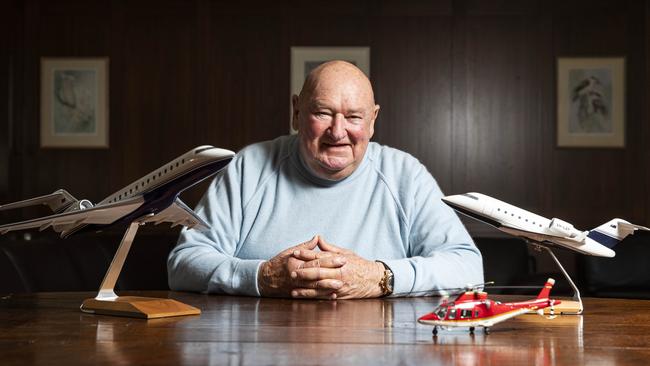Flying Fox to rescue with fire-fighting air fleet
Linfox group and Coulson Aviation have temed up to create Australia’s first high-capacity fire and emergency aviation service, operating both day and night.

Lindsay Fox has a dire warning for the looming Australian summer.
“I am expecting this year the same scenario we have seen in California hitting the traditional areas of bushfire in Australia,’’ the billionaire trucking magnate tells The Weekend Australian.
It is why his Linfox group has teamed up with the American-Canadian firefighting company Coulson Aviation to create Australia’s first high-capacity fire and emergency aviation service that can operate both day and night.
The proposed fleet of large, fixed-wing air tankers, super-heavy helicopters and fire intelligence-gathering aircraft will be based and operated throughout the country, with maintenance and support infrastructure supplied in NSW and Victoria.
“When I was in the boy scouts, to start a fire you rubbed two matches together. You didn’t have any paper. And how did you put it out? You pissed on it,’’ Mr Fox said.
“What we need is a national approach to fire-fighting so we can have planes capable of picking up water or fire retardant and dropping it in strategic locations. We are not prepared for the worst. On the east coast of America they drench the forests before the summer. We don’t do that.”
The consortium plans to set up remote bases where aircraft can safely reload retardant close to a live fire zone, rather than having to fly, sometimes for hours, to the nearest airport and back.
The Fox-Coulson consortium is run by a steering committee that includes former secretary of Defence Dennis Richardson and former PwC chief executive and executive chairman of investment advisers Sayers, Luke Sayers.
Last week, the bushfire royal commission’s final report recommended the creation of a new national aerial firefighting fleet funded by state and federal governments. The inquiry heard evidence that aircraft weren’t shared between states and territories last year because of the intensity and length of the Black Summer bushfire season, which left 33 people dead and thousands homeless.
“The royal commission’s recommendations make it clear that coming fire seasons are going to be longer and more dangerous than ever before. A national approach to firefighting is urgently needed,’’ Denis Richardson said.
The report found the cost of the crisis ran to billions of dollars, and it warned about the rising threat from climate change.
“I’ve been looking for a way to build a national emergency fire and disaster response for years, so I’m relieved to see the royal commission agrees that we need one — and urgently,” Mr Fox said.
“I’m just a proud Australian who loves fixing problems, and our country is currently facing one of its biggest problems ever. Now is the time to come together. The suffering has to stop. This is the solution that is going to help my fellow Australians. It’s going to save lives.”
Asked if he agreed with the royal commission’s findings on the bushfire threat posed by climate change, Mr Fox replied: “Without a doubt. Just look at what has happened in North America, particularly along the California coast.”
Linfox Airports managing director David Fox said the new aerial firefighting operation would have 12 aircraft nationwide, initially employing 300 people.
He said the fleet would grow to up to 40 aircraft over the next three to five years and have $120m in assets, including a world-class training facility and a centre of excellence for more than 1400 staff and volunteers.
Linfox Airports has long owned Avalon Airport, west of Melbourne.
Coulson Aviation, a family owned business with global operations in Australia, Canada, Chile, and the US, lost three of its American staff fighting last year’s NSW bushfires when their C-130 Large Air Tanker crashed near Cooma.
Chairman of Coulson Aviation Australia, Wayne Coulson, said the consortium’s fleet would bring cutting-edge night-time aerial firefighting capabilities to future fire seasons.
“In our experience, with a technology-based approach, fighting fire at night can be just as effective as during the day. During the day, we’re responding to an emergency situation, there are other aircraft around, there’s panic on the ground and you’re reacting,’’ he said. “At night, the advantages are higher humidity, lower temperature and typically lower winds. You own the airspace and can control the situation much more efficiently and effectively.”








To join the conversation, please log in. Don't have an account? Register
Join the conversation, you are commenting as Logout